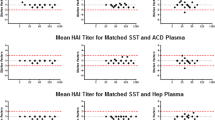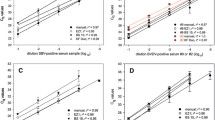Summary
We investigated whether an ordinary centrifuge can achieve the standard centrifugal effect required according to specifications for infectious disease screening using the Abbott i2000. Samples were collected and centrifuged following a standard operating procedure (SOP). They were then divided into three groups according to the results of the initial screening tests: a negative group, weak-positive group, and positive group. Twenty negative samples and all weak-positive and positive samples were re-analyzed. Two tubes for each re-analyzed sample were centrifuged simultaneously, one for 10 min at 10 000 × g, per recommendations, and one for 10 min at 2750 × g. No significant difference was found between the groups using different centrifugal forces. There was a strong correlation in the quantitative values between the two conditions of centrifugation. Consistency analysis showed a Cronbach’s alpha > 0.8 for detection of Treponema pallidum, human immunodeficiency virus (HIV), hepatitis C virus (HCV), and hepatitis B surface antigen in the three groups (negative group, weak-positive group, and positive group) under different centrifugation conditions. Strong consistency was found under different centrifugal conditions, regardless of the initial testing results. In conclusion, we conducted centrifugation steps in duplicate, according to infectious disease screening protocols. Our study showed that all samples should be centrifuged using a recommended relative centrifugal force after a proper clotting time, as in the standard operating procedure of our laboratory. In this way, we were able to obtain the same results using an ordinary centrifuge as those obtained using a high-speed centrifuge, such as the Abbott i2000.
Similar content being viewed by others
References
WHO. World Health Statistics 2018. https://apps.who.int/iris/bitstream/handle/10665/272596/9789241565585-eng.pdf?ua=1
WHO. Global health sector strategy on viral hepatitis 2016–2021. https://apps.who.int/iris/bitstream/handle/10665/246177/WHO-HIV-2016.06-eng.pdf?sequence=1
WHO. WHO guidelines for the treatment of treponema pallidum 2018. https://www.researchgate.net/publication/319321749_WHO_Guidelines_for_the_Treatment_of_Treponema_pallidum_Syphilis
WHO. HIV infected data. https://www.who.int/hiv/data/en/.
Adcock Funk DM, Hoefner DM, Kottke-Marchant K, et al. Collection, transport and processing of blood specimens for testing plasma-based coagulation assays and molecular hemostasis assays; approved guideline, 5th ed. Wayne PA: Institute CLS, CLSI document H21-A5, 2008.
Kirwan JA, Brennan L, Broadhurst D, et al. Preanalytical Processing and Biobanking Procedures of Biological Samples for Metabolomics Research: A White Paper, Community Perspective (for “Precision Medicine and Pharmacometabolomics Task Group”-The Metabolomics Society Initiative). Clin Chem, 2018,64(8):1158–1182
Acar A, Kemahli S, Altunay H, et al. The significance of repeat testing in Turkish blood donors screened with HBV, HCV and HIV immunoassays and the importance of S/CO ratios in the interpretation of HCV/HIV screening test results and as a determinant for further confirmatory testing. Transfus Med, 2010,20(3):152–159
Kazmierczak SC, Sekhon H, Richards C. False-positive troponin I measured with the Abbott AxSYM attributed to fibrin interference. Int J Cardiol, 2005,101:27–31
Chavez P, Wesolowski L, Patel P, et al. Evaluation of the performance of the Abbott ARCHITECT HIV Ag/Ab Combo Assay. J Clin Virol, 2011,52(Suppl 1):S51–S55
Jensen TO, Robertson P, Whybin R, et al. A signal-to-cutoff ratio in the Abbott architect HIV Ag/Ab Combo assay that predicts subsequent confirmation of HIV-1 infection in a low-prevalence setting. J Clin Microbiol, 2015,53(5):1709–1711
Wang LC, Chen W, Yu Y. The Performance of the Abbott i2000 for Measuring Serum Markers of Infectious Diseases. J Clin Lab Anal, 2017,31(1):1–9
Kim AA, Parekh BS, Umuro M, et al. Identifying Risk Factors for Recent HIV Infection in Kenya Using a Recent Infection Testing Algorithm: Results from a Nationally Representative Population-Based Survey. PLoS One, 2016,11(5):e0155498
China National Accreditation Committee for Conformity Assessment, Guidance on the Application of Accreditation, Criteria for the Medical Laboratory Quality and Competence in the Field of Clinical Qualitative Immunology, NAS-CL02-A004:2018
Lippi G, Banfi G, Church S, et al. Preanalytical quality improvement. In pursuit of harmony, on behalf of European Federation for Clinical Chemistry and Laboratory Medicine (EFLM) Working group for Preanalytical Phase (WG-PRE). Clin Chem Lab Med, 2015,53(3):357–370
An Z, Li SP, Li MX, et al. Effect of high speed centrifugation on the retesting results of serum markers of four blood-borne infectious diseases. Biaoji Mianyi Fenxi Yu Linchuang (Chinese), 2016,23(1):91–94
Yu S, Shen AZ, Liu ZY, et al. Effect of centrifugation conditions on detection of hepatitis B surface antigen by Sysmex HISCL-5000. Hainan Med J (Chinese), 2018,29(15):2117–2121
Author information
Authors and Affiliations
Corresponding author
Additional information
Conflict of Interest Statement
The authors declare that they have no competing interests.
Rights and permissions
About this article
Cite this article
Xu, Dj., Wang, Kd. & Wu, J. Different Re-centrifugation Conditions for Infectious Disease Screening Using the Abbott I2000. CURR MED SCI 40, 110–116 (2020). https://doi.org/10.1007/s11596-020-2153-9
Received:
Revised:
Published:
Issue Date:
DOI: https://doi.org/10.1007/s11596-020-2153-9




